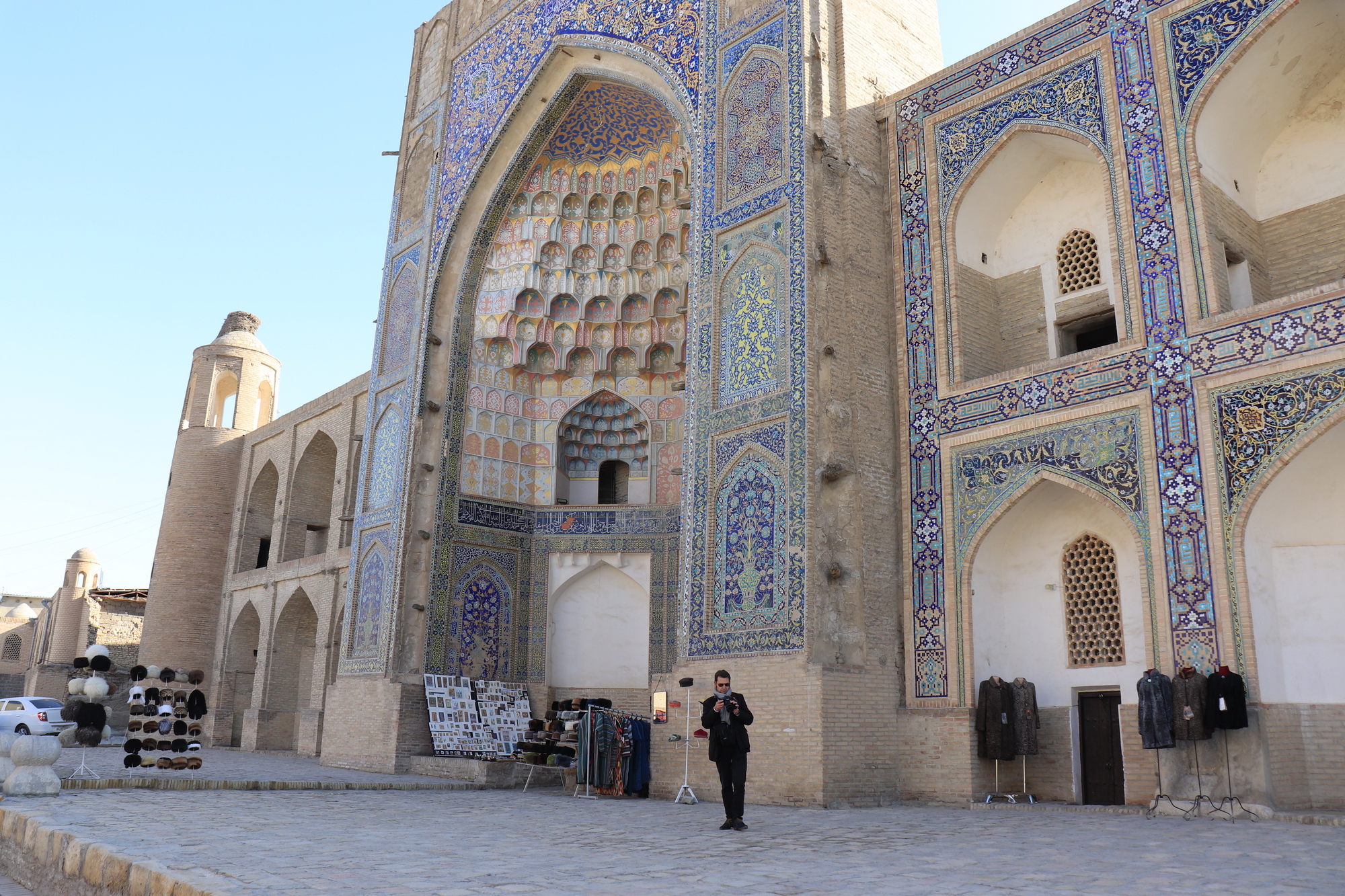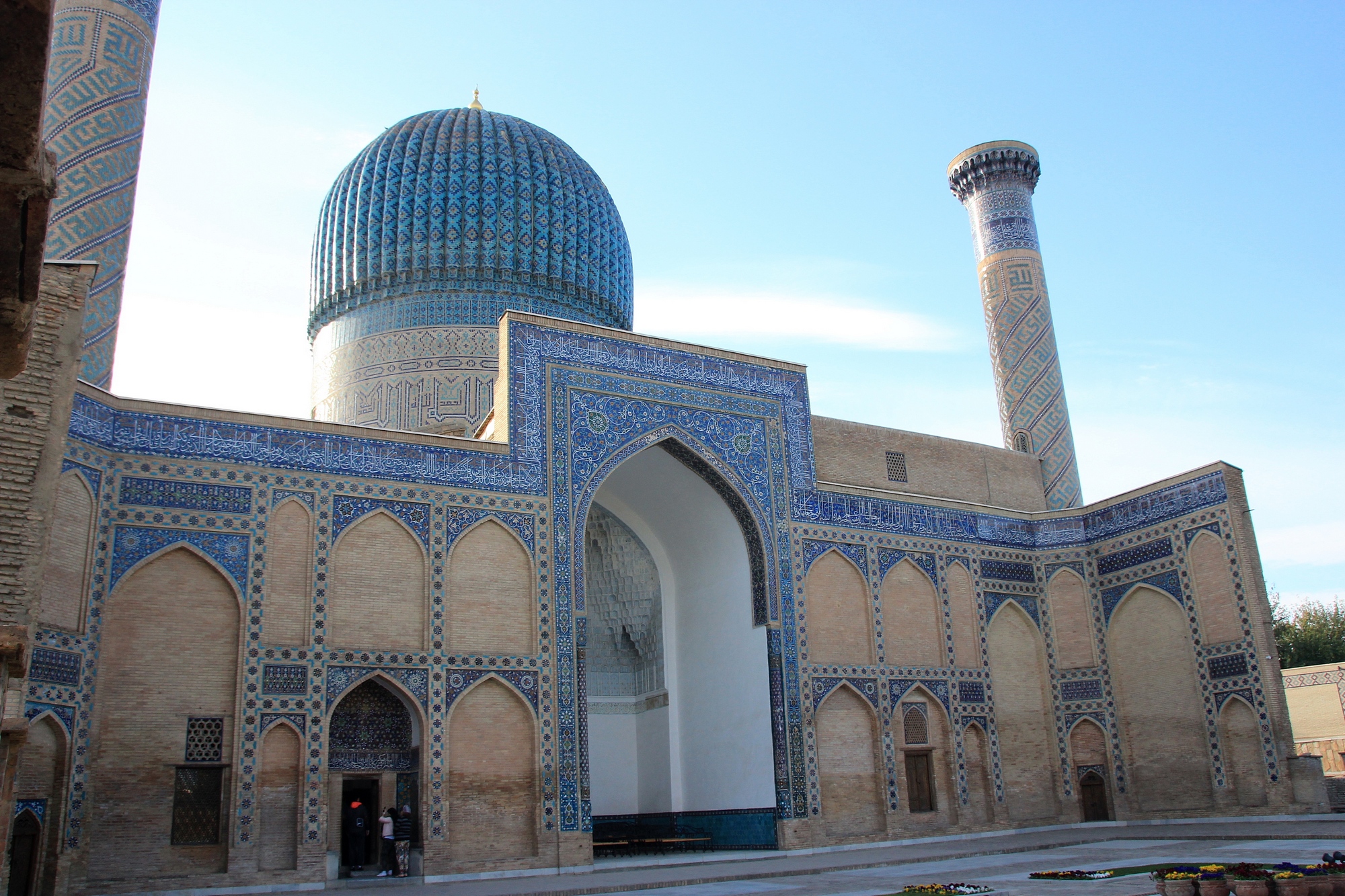The nearest travel dates: April 28 – May 9. You can also choose the dates that are convenient for you. The most favorable weather conditions for traveling are April, May, June, September, October.
The geological and cultural heritage of Uzbekistan is diverse and attractive. Nowhere else in Central Asia, such a variety of UNESCO sites is concentrated as in Uzbekistan. It is here that the connection between history and natural landscapes is observed. In the proposed tour you will plunge into the Ancient East, which is presented to tourists in Uzbekistan in its brightest colors and monumental architectural monuments of ancient cities. You will get acquainted with the most interesting geological objects and picturesque natural landscapes. Against their background, you will see the world-famous monuments of the legendary ancient Samarkand and Shakhrisabz, as well as the ascetic Gilan village and other ethnographic sights. You will see grandiose canyons, karst plateaus, the world stratigraphic standard, the real life of mountain villages. Taste delicious dishes of real Uzbek cuisine, appreciate the skill of artisans. The tour will be of interest not only to geologists, students, schoolchildren, but also to a wide range of tourists who love history, nature and adventure.
PROGRAM
Day 1. Arrival in Tashkent
Relaxation. After lunch, a tour of Tashkent – the capital of Uzbekistan: Old City, Barak-Khan madrasah (XVI century), Yunus-Khan mausoleum, Kafal-al-Shashi Mazar mausoleum (XVI century), Kukeldash madrasah (XVIII century), Chorsu bazaar and shopping, Independence Square, Peoples’ Friendship Square, the building of the National Opera and Ballet Theatre. Dinner, transfer to the railway station. Transfer by night train (sleeping car) from Tashkent to Termez at 21:35.
Day 2. Arrival in Termez at 11:30. Light breakfast on the train
Termez is the most ancient city in the south of Uzbekistan, located on the right bank of the Amu Darya River. Excursion to the Archaeological Museum, where more than 40 thousand unique exhibits are collected. Hotel accommodation. Dinner. After lunch, a trip to Kampyr-tepa, an ancient (more than 2500 years old) port city on the Amu Darya, identified by scientists with Alexandria Oxiana. Continuation of excursions: Fayaz Tepa – Buddhist monastery – UNESCO site, Kyrk-Kyz Complex – an interesting and mysterious architectural structure, temple of fire worshipers, khanaka of dervishes. Rest in the hotel. Dinner.
Day 3. Transfer to Denau (150 km. 3 hours)
On the way visit the original Jarkurgan Minaret (XI-XII c.). Lunch at Denau. Transfer to the foothills of the Hissar Range to the most beautiful multi-jet karst Sangardak waterfall – a griffin falling from numerous holes from the middle of a huge rock (50 km, 1 hour). Here you can also see the karst cuestas of the Baisuntau ridge, breaking off to the east with 300-meter walls. Return to Denau. Dinner. Overnight at the hotel.
Day 4. "Moving to the "Martian mountains"
Easy 2.5 hour hiking among the red bizarre monolithic red sandstone cliffs. Observation of the flights of numerous vultures nesting in impregnable rocks. Lunch – picnic. Transfer to the district center of Baysun – UNESCO Intangible Heritage Site “Ethnic Cultural Space of Baysun” (km, 2.5 hours). Excursion to the picturesque “Red Canyon”. Visiting a local crafts center, getting to know the locals and their way of life. Overnight at the hotel.
Day 5. Transfer to the Derbent village
From Derbent, an excursion to the grandiose Derbent canyon and Kaptarkhona canyon, the village of Yukara Machai and the karst vaucluse Khuzhamoy ata. Acquaintance with the geological sections of the region. Transfer to Shakhrisabz – the birthplace of Amir Temur, the greatest commander of the Middle Ages and the head of a vast empire (200 km, 3.5 hours). Dinner. Tour of Shakhrisabz: Ruins of Ak-Saray Palace (1380–1404), Doruttilyavat Ensemble (XIV-XV centuries), Dorussiadat Ensemble (XIV century), Amir Temur Monument, Kok Gumbaz Mosque (1435), Jami Mosque (1915), Mausoleum of Jahangir (XIV c.), Trading dome “Chor-su”.: Dinner. Overnight at the hotel.
Day 6. Trip to the picturesque high-mountainous Gilan village (km, 2.5 hours)
The path lies through the Gissarak reservoir, the grandiose canyon of the Aksu River. Stops at interesting geo objects along the way. Gilan is located at an altitude of 2000 m above sea level. In the vicinity of the village, there are practically no even and flat plots of land where it is possible to use a tractor, and the peasants are forced to cultivate potato fields on steep (up to 40 degrees) mountain slopes almost by hand, using a simple plow drawn by a pair of bulls or donkeys. Orchards are also cultivated on steep slopes and river gorges. A special pride of the inhabitants of the village is an extensive irrigation network of man-made canals laid on the mountain slopes for tens of kilometers. The most famous mountain potato in Uzbekistan grows here. Walking around the village and its most picturesque surroundings, getting to know the life and traditions and crafts of local residents. Dinner with local folklore. Overnight in a family guest house.
Day 7. Gilan - Kitab Geopark
Transfer to the Kitab National Natural Geopark, where, along with the picturesque mountain landscapes of the park, the main objects are the unique geological stratigraphic sections Zinzilbane and Khodzhakurgon and the remains of ancient fossil forms of marine animals and plants contained in them. A visit to the Zinzilban section, recognized as the world standard stratigraphic standard, the so-called “GOLDEN NAIL” of the lower boundary of the Emsian stage of the Devonian period of the Paleozoic era (400 million years). The Kitab Geopark is truly a geological chronograph of the earth. We will also visit the local geological museum with a collection of minerals, fossils, flora and fauna. Overnight at the Geopark hotel.
Day 8. Geopark - Samarkand
Today we are moving to Samarkand (220 km, 3.5 hours). Our path to the north lies through the Zeravshan mountain range, the Takhta-Karacha pass, 1675 m – the highest point of our route on this day. On the way, stop for viewing geomorphological monuments and paleontological sections, the Shaitan-Dzhilga plateau with huge bizarre weathered granite boulders, the holy place of Khazrat Bashir with a spring, centuries-old plane trees, pomegranate gardens in the valley of the Kashkadarya River. Dinner. Excursion program in Samarkand: “Heart” of Samarkand – Registan Square (XIV-XVI centuries) with 3 famous madrasahs: Sherdor, Ulugbek and Tilla-Kori, the grandiose cathedral mosque Bibi-Khanum (XV century), the magnificent mausoleum of Gur- Emir (XV century), in which Tamerlane, his sons and grandson Ulugbek are buried. Exotic Siab Bazaar. Overnight at the hotel.
Day 9. Samarkand - Nurata
Today we will visit the Bogambir Geopark – the Koytash tungsten deposit and the Koytash rock sculptures (rock garden). Here we will visit places where paleontological artifacts have been found. We will see geological structures and amazing landforms. As well as geodynamic geological structures. In the evening transfer to Nurata – a small town on the border of the mountains and the Kyzylkum desert. Excursion to the place of pilgrimage NUR. Overnight at the hotel.
Day 10. Nurata - Sarmysh - Gijduvan - Bukhara
Today we are leaving for fabulous Bukhara, one of the most ancient cities of the East. On the way, we stop at the Sarmysh petroglyph park, where an “art gallery” with more than 3,000 drawings from the Neolithic period is located on black basalt rocks. Next, we will have lunch and talk with the Narzullaev dynasty of ceramists in their house-workshop in the small town of Gijduvan. Upon arrival in Bukhara, hotel accommodation, rest and tour of the old city: Lyabi-Hauz complex (XVI-XVII centuries) – the “heart” of old Bukhara; Poi-Kalyan complex (XII-XVI centuries) with Miri-Arab madrasah (XVI century), Kalyan mosque (XV century) and Kalyan minaret (XII century) 46.5 meters high; trade domes of Bukhara (XVI century); The Ark Citadel (7th-19th centuries) is the oldest building in the city. Overnight at the hotel.
Day 11. Bukhara - Tashkent
In the morning, excursions continue: Mausoleum of the Samanids (IX – X centuries) – the tomb of the rulers of Bukhara; The mausoleum-sarcophagus of Chashma-Ayub (XIV-XIX centuries) Chor-Minor Madrasah, the country residence of the Bukhara emirs of Sitor Mokhi-Khosa. Transfer to Tashkent by high-speed train Afrosiab, 15.50, 19.10. Overnight at the hotel.
Day 12. Flight home
Transfer to Airport
The cost of the tour (12 days) will be:
| Number of persons | 2 | 3 | 4 | 5 | 6 | 7 | 8 |
| Cost (USD/person) |
| Number of persons | 9 | 10 | 11 | 12 | 13 | 14 | 15 | 16 |
| Cost (USD/person) |
The tour price includes:
- Accommodation in double rooms in hotels (or similar):
Tashkent – Uzbekistan 3*+
Zaamin National Park – Plato 3*
Samarkand – City Samarkand 3*
Kitab Geological Reserve – Geopark Hotel 2*
Shakhrisabz – Kesh Palace 3*
Bukhara-Sultan 3*
Transport according to the program: Hyundai Starex minibuses, up to 7 passengers in 1 car (or similar)
Accompanying guide with knowledge of geology (days 2-8)
Accompanying guide-interpreter (days 2-8)
Entrance tickets to the main monuments
Railway ticket for the train “Afrosiab” Samarkand-Tashkent
Meals – full board, according to the program
Mineral water
The price does not include:
- Single accommodation in hotels
Local guides in cities
International flights
Expenses for photo / video shooting in museums
Medical insurance
All services not mentioned above
Attention!
- – Check-out time in hotels check-in at 14:00, check-out at 12:00;
– Surcharge for early check-in before 7:00 am – 100%, from 7:00 to 14:00 – 50% of the cost.
– Breakfast time – 08:00, lunch – 13:00, dinner – 19:00. Time shifts at will
Our email: info@geoexplorersclub.com



















